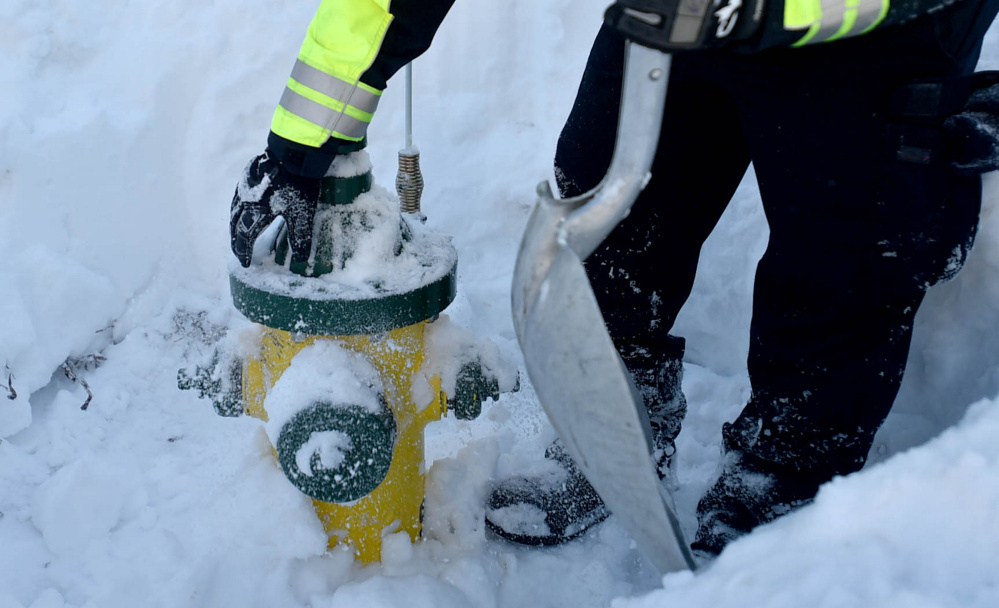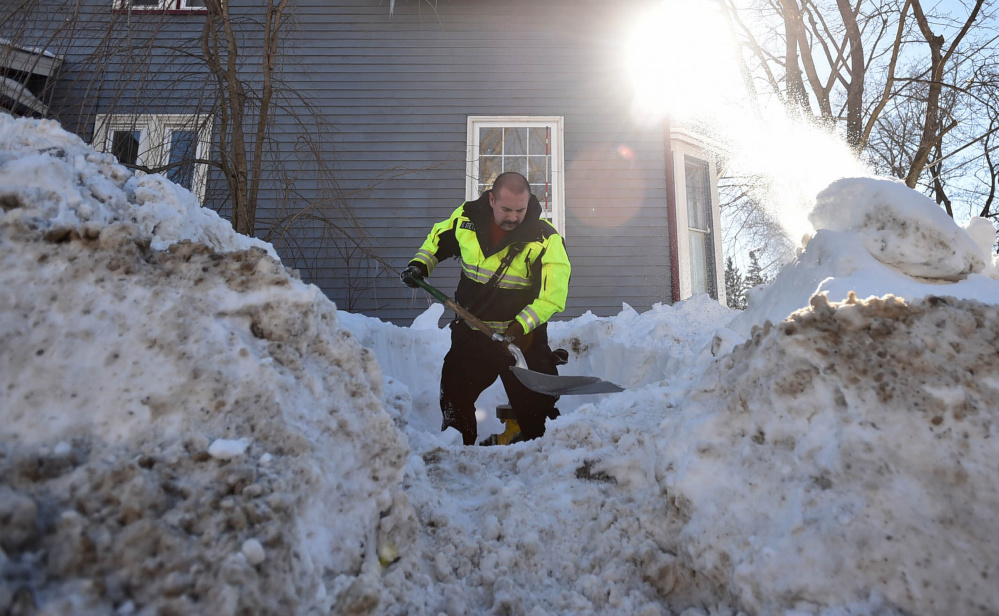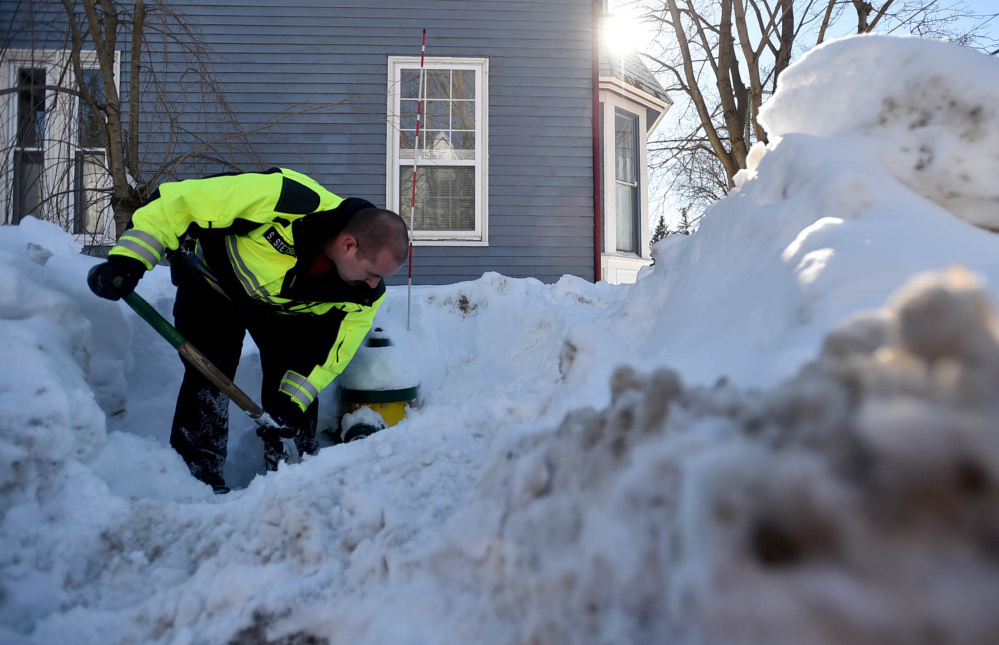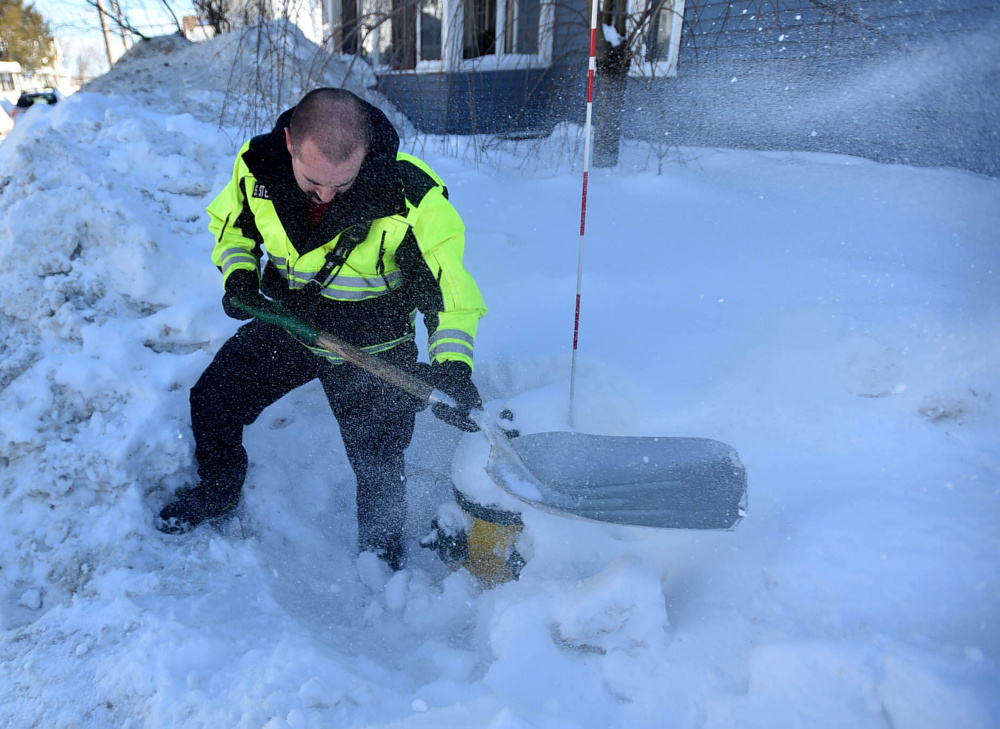Cities and towns in central Maine continue to try to find places to put the massive amounts of snow from recent snowstorms, and many sidewalks in the region remain un-shoveled and buried in several feet of snow.
But officials say an often overlooked part of shoveling is often the most important one: fire hydrants.
Hydrants often pepper downtown areas and are scattered throughout most neighborhoods, but are usually just a few feet tall. The recent blizzard-like snowfall from last Sunday into Monday left many hydrants completely buried, putting firefighters at risk of not having access to immediate access to water if they’re called to fight a blaze.
Such an instance happened in Skowhegan, when firefighters arrived on scene to a structure fire on Main Street on Tuesday and had to dig out a hydrant before they could fight the fire. That same night, the Fairfield Police Department posted a message on Facebook, asking residents to help shovel out fire hydrants near their homes.
“It takes time for guys to shovel because it hasn’t been cleaned,” said Waterville-Winslow Fire Chief David LaFountain. “It ties up resources we could use in actually fighting the fire.”
While task of shoveling out fire hydrants isn’t always easy, it can be hard also determining who’s responsible for making sure hydrants are free of snow. That answer varies between from community to community, and no matter the agency ultimately responsible, local officials are still asking residents to help out and shovel out hydrants near them.
LaFountain said there are more than 300 hydrants in Waterville alone, and the department also serves other surrounding towns with additional hydrants. As per an agreement with the city’s water district, LaFountain said the fire department is in charge of clearing and maintaining all the hydrants.
“We use our pickup truck with a plow to clear as many hydrants as we can and we bring in as many people as we can,” LaFountain said, meaning it is firefighters who do all the clearing. He said it can be difficult to get to hydrants, and they often have to drop what they’re doing and head out to a call if one comes in.
‘PLENTY OF WORK’
Other towns and cities rely on the water districts to clear snow from hydrants.
Augusta Fire Department Deputy Chief Dave Groder said the Greater Augusta Utility District is in charge of clearing the hydrants of snow in the capital city. He said the company was doing its best to keep the hydrants clear, and said high priority areas seemed to be cleared.
He said the only time the fire department would shovel out a hydrant was if they encountered a buried one and needed access to it.
“It doesn’t seem to be an issue at this point,” Groder said.
Andy Begin, general assistant manager for the Greater Augusta Utility District, said there are about 500 hydrants in Augusta to maintain. He said with back-to-back storms, as was predicted this past week, it can be difficult to get the hydrants so they may have to assess whether to wait until after the second storms hits.
“It takes a while to get crews out and clean them all up,” Begin said.
It’s a similar story in Skowhegan. Fire Department Capt. Rick Caldwell said the town’s fire hydrants are cleared by Maine Water, which serves towns from Old Orchard Beach and Saco, up through Rockland and into Millinocket. Caldwell said Skowhegan has more than 100 hydrants in town, and with the current staffing numbers as well as all the other duties the department has, there was no way the Skowhegan Fire Department could get to all the hydrants.
“We realize depending on when a call happens and when there’s a storm we may have to do some quick shoveling, like we had to do the other night,” Caldwell said.
Fairfield Fire and Rescue Department Capt. Jim Lane said his department and the town’s Public Works Department tackle digging out hydrants together. He said at this point, they are reclaiming hydrants, not just digging them out.
“We’re literally opening up 5, 6 feet around them in hopes we can keep up with them the rest of the winter,” he said.
Lane said he wasn’t sure where the exact responsibility of clearing hydrants fell, but standard practice had been a joint effort between fire and public works.
LaFountain said Waterville’s hydrants are broken down into three sections: north, south and central. He said he wasn’t sure if even one of those sections had all its hydrants free and clear of snow.
“We still have plenty of work,” LaFountain said.
Fairfield is still working to dig out its 100 hydrants. Lane said he spent eight hours on Feb. 14, and said at this point most of the north and south end hydrants were reclaimed. He said next they will tackle the interior of town heading out towards Fairfield Center.
“It’s an on going process, hopefully with stretch of good weather hopefully we can catch up with the 100 or so in our area,” he said.
HYDRANT HELP
But the problem, Lane said, is finding the personnel to dig out the hydrants. In past years the department has struggled to find volunteer firefighters. And assigning the task to full time, on-duty firefighters is problematic, because then there are less people available to respond to an incoming emergency call.
But Lane said a recent trend of residential help has been appreciated.
The Fairfield Police Department was not alone in taking to social media asking for residents to help the cause. The Facebook page for the city of Waterville shared the Fairfield post, asking residents to help clear out fire hydrants near their homes, writing that the “consequences of not doing it could be absolutely devastating.”
The Facebook page for Waterville Fire and Rescue on Thursday praised Mayor Nick Isgro for clearing out a fire hydrant near his Waterville home, which Isgro also shared on his Facebook page. Isgro responded on his mayor’s Facebook page saying, “Thank you Waterville Fire-Rescue. You set the standard, and we follow!”
LaFountain said they always appreciate when residents help clear out the hydrants, and he said posting messages to Facebook can be a good idea, as it always helps having a fire hydrant ready to go.
The trouble can come with finding the hydrants, though, especially once they’re buried under mountains of snow.
LaFountain said hydrants have rods with reflective red and white stripes on them that stick up, but those can also get buried by snow, either by plows or by residents not realizing it. This violated city ordinance, he said.
One habitually difficult Waterville hydrant, he said, is on Kennedy Memorial Drive by the former Weathervane restaurant, which has since been demolished. This location is right off Interstate 95, and he said plows coming by tend to bury the hydrant with snow.
“There are some hydrants that are short to begin with,” he said.
But LaFountain said it is always helpful when they find a citizen has cleared out a hydrant. They have a list of the hydrants, and when they go to shovel one out and discover the work is already done, he said they’re thankful and move on to the next one.
Lane, of Fairfield, said there has been a recent trend of residents who have “adopted” hydrants in their area, and said they are extremely appreciative for that. He said even if a resident just begins clearing out a hydrant, Fire and Rescue or Public Works could come in and finish the rest.
“We always talk to people and say it,” Lane said of residents pitching in. He said the town’s Police Department posting their message was evidence of the camaraderie between police, fire and rescue and public works.
For example, he said Public Works helped their department by rushing to the scene of the Feb. 16 fire on Ohio Hill Road in Fairfield and cleared out two hydrants for firefighters.
“They responded quickly so we had a water source,” Lane said.
Colin Ellis — 861-9253
cellis@centralmaine.com
Twitter: @colinoellis
Send questions/comments to the editors.







Comments are no longer available on this story